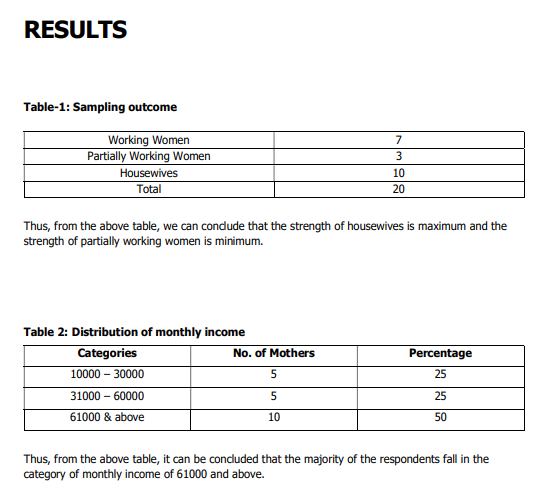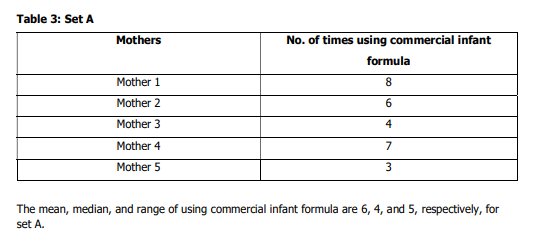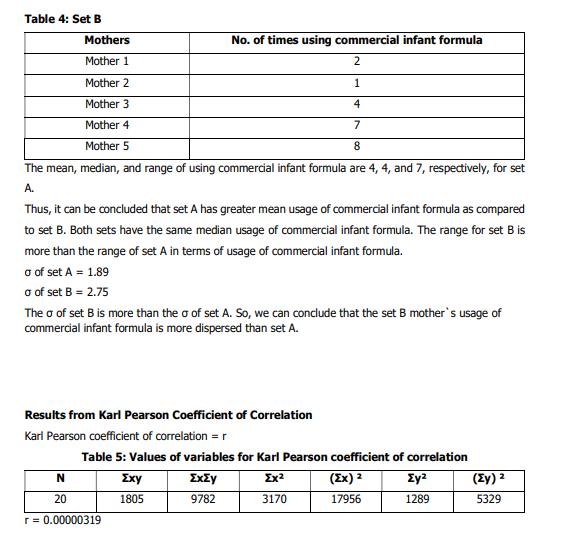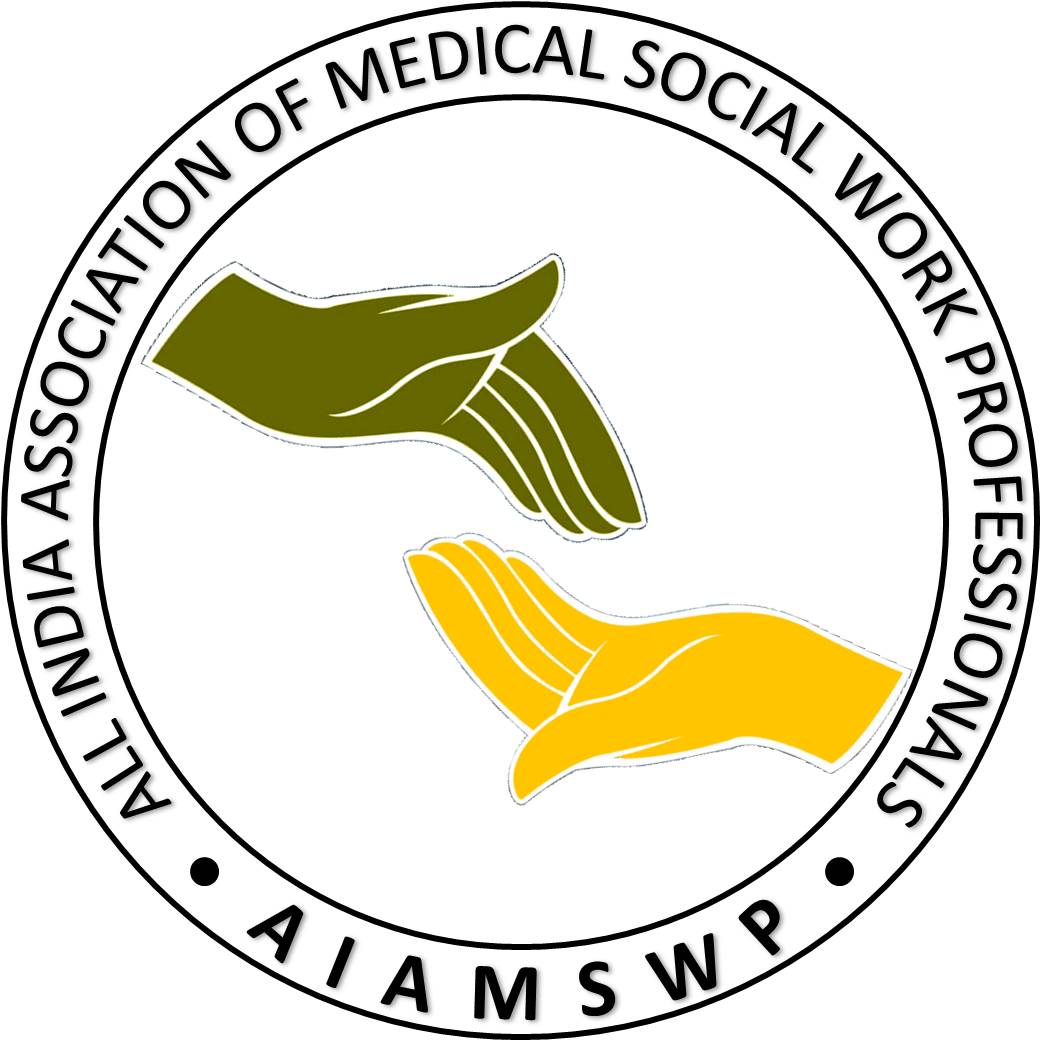Indian Journal of Health Social Work
(UGC Care List Journal)
Menu
TRENDS IN INFANT FEEDING PRACTICES: UNDERSTANDING
MATERNAL CHOICES
Kheyali Roy1 & Shaurya Prakash2
1Kheyali Roy, Assistant Professor (Senior), Department of Social Work, Assam Don Bosco
University, Guwahati, Assam, 2Shaurya Prakash, Research Scholar, Department of Social Work,
Visva-Bharati, Santiniketan, West Bengal, India.
Correspondence: Shaurya Prakash, E-mail: sauryap75@gmail.com
ABSTRACT
There is much controversy between breastfeeding and commercial infant formula. Very often,
infant formula has caused ailment and even mortality to infants worldwide – hence the continuous
campaign of the World Health Organisation (WHO) and UNICEF, along with other breastfeeding
advocates, for mothers to breastfeed their children at least until 6 months of age. Infant feeding
practices generally meet the baby’s nutritional and immunological needs. This study of infant
feeding practices is carried out on a sample of 20 mothers and infant pairs. The objective of the
study is to know the feeding practices of mothers, the problems faced by working mothers,
and the usage of commercial infant formula instead of breast milk. This study reflects upon the
feeding practices among working women and housewives and also about the health status of the
mothers.
Keywords: Feeding practice, infant, mothers, breast milk, working women
INTRODUCTION
Infant feeding practices generally meet the
baby’s nutritional and immunological needs.
World Health Organization and UNICEF
recommend a global strategy, i.e., early
initiation of breastfeeding within one hour of
birth and exclusive breastfeeding for the first
six months. Supplementary foods that are safe
and nutritious are introduced at six months
of age, and breastfeeding is maintained until
the child is two years old or older.
Breastfeeding has a beneficial effect on the
health of women.
Breastfeeding helps lose pregnancy weight
faster (Kramer & Kakuma, 2012; Baker et al.,
2008; Sanusi & Falana, 2013). A study
revealed that breastfed women lose 4.4
kilograms in a year, compared to 2.4
kilograms for non-breastfeeding women
(P<0.5) (Dewey et al., 1993). This underlines
the effectiveness of breastfeeding, especially
if practiced exclusively in the first six months,
in reducing weight gain during pregnancy.
Breastfeeding promotes uterine contraction,
thereby reducing blood loss after delivery and
promoting uterine involution (NRDC, 2005).
Breastfeeding reduces the risk of type 2
diabetes and cardiovascular diseases
(Davis et al., 2012). It also lowers the risk of
breast, endometrial, and ovarian cancers
(Labbok, 2001; NRDC, 2005; Centre for
Community Child Health, 2006; Huo,
Adebamowo, 2008; Sule, 2011; Davis et al.,
2012). The absence of menstruation due to
breastfeeding serves as temporary contraception for some women (Kuti et al.,
2007). According to a World Health
Organization (WHO) study, frequent, ondemand breastfeeding is continued until two
years of age or beyond. The plan includes six
targets, one of which is to increase by 2025
the rate of exclusive breastfeeding for the first
six months up to at least 50%. Activities that
will help to achieve this include those outlined
in the “Global Strategy for Infant and Young
Child Feeling”, which aims to protect,
promote, and support appropriate infant and
young child feelings.
Healthy eating was a top priority for expectant
moms and mothers with at least one kid under
two years old. Still, they either used expert
recommendations inconsistently or in a fashion
that only partially reflected their
understanding of the best child-feeding
practices. Although the moms used online and
in-person social networks to obtain
information about infant feeding, their
instincts about what is best for their child were
the primary guidance for their decisions.
Positive, encouraging messages from reliable
medical sources were appreciated, but
clinicians were the least often cited source of
knowledge on child feeding. A nutritious diet
for their children was a top priority for
expectant moms and mothers with at least one
kid between the ages of 0 and 2. Nevertheless,
they either used expert recommendations
inconsistently or in a manner that only
partially reflected their awareness of the best
practices for child feeding. Although the moms
used online and in-person social networks to
obtain information about infant feeding, their
instincts about what is best for their child
served as the primary guidance for their
decisions. Positive, encouraging messages
from reliable medical sources were
appreciated, but clinicians were the least
often cited source of knowledge on child
feeding. These findings can be used by
clinicians to help parents make decisions on
feeding their young children. Finding the best
ways to collaborate with parents and support
their efforts to feed their children healthily is
crucial, especially in light of the high
prevalence of childhood overweight and
obesity, the severe short- and long-term
physical and mental effects of childhood
excess weight, and the significance of early
childhood feeding practices on long-term
health, body composition, and eating
behaviors. (Weber, M. B., Palmer, W., Griffin,
M., & Welsh, J. A., 2023)
In order for policymakers and the general
public around the world to acknowledge the
mounting scientific evidence that
breastfeeding is the most evolved and suitable
feeding strategy for maximizing the survival,
health, and well-being of both mothers and
infants, it is necessary to invest in public
awareness and education. It is necessary to
implement comprehensive health education
campaigns aimed at the general public and
policymakers in order to dispel
misconceptions regarding the similarities
between breast milk and commercial milk
formula (Pérez-Escamilla, Rafael, et al.,
2023).
According to the criteria applied in this
analysis, the percentage of Indian infants who
were exclusively breastfed for six months
increased from 31.3% in the NFHS-4 (2015–
16) survey to 43% in the NFHS-5 (2019–2021)
survey. Mothers from the scheduled tribe
group who gave birth at public health facilities
and who got at least four prenatal visits during
their pregnancy were more likely to nurse
their babies exclusively for up to six months.
A lower chance of being exclusively breastfed
for up to six months of life was linked to
younger women (less than 24 years old), low
birth weight (less than 2000 g) babies, higher
birth order babies (more than three), and
breastfeeding that began more than an hour
after birth. There was no relationship between
exclusive breastfeeding for six months and the infant’s gender, wealth index, or place of
residence (rural or urban). (Reddy N, S.,
Dharmaraj, A., Jacob, J. et al.,2023)
The previous studies have touched on various
aspects relating to the feeding practices of
mothers, but none of the studies seems to
have touched the area relating to awareness
regarding the feeding practices and details of
the mother‘s as well as the child‘s health.
METHODS & MATERIALS
A crucial component of every research is
outlining the goal and offering a convincing
justification. This allows the work to be placed
within the framework of the theory and
evidence currently in use, as well as its realworld applications. The goal of the current
study, as developed by the researchers, is to
determine how breastfeeding troubles are
experienced by the mother. Because there are
a lot of babies in these two Rampurhat wards,
they also looked into the state of feeling
practices there. They are particularly
interested in working with women and
children. The present study helps to
understand the feeding practices among
working women as well as housewives and
health strategies. The major objectives of the
study are to know the feeding practices of
mothers nowadays, to know the problems
faced by working women while breastfeeding,
and to explore the usage of commercial infant
formula instead of breast milk.
In this study, the researchers adopted an
eclectic research design. Eclectic research,
better known as mixed method, is defined as
a research method that describes the
characteristics of the population or
phenomenon that is being considered by the
researchers.
The research aims to gather information
about a large number of people. The present
research also follows a survey research
design, which helped the researcher to have
a clearer understanding of breastfeeding
practices.
The researchers conducted the study on the
factors affecting the infant feeding practices
of mothers in Ward No.- 5 & 7 in Rampurhat.
These two wards are adjacent to each other,
having mixed communities that consist
of working women, partially working women,
and housewives. The socio-economic
condition of this area is average. The entire
population is involved in some kind of
livelihood-generating work. So, the people of
these two wards are not poor. Some of them
have RSBY (Rashtriya Swasthta Bima Yojana)
cards and fall under the BPL (Below Poverty
Line) category. Most of them have good socioeconomic conditions.
The researchers used random sampling and
purposive sampling methods for conducting
the study by selecting mothers of various ages
across these two wards. A purposive sample
is a non-probability sample that is selected
based on the characteristics of a population
and the objective of the study. Purposive
sampling is also known as judgmental,
selective, or subjective sampling. This type
of sampling can be very useful in situations
when you need to reach a targeted sample
quickly and where sampling for proportionality
is not the main concern. A cross-sectional
survey was conducted using an interview
schedule in English language.
The researchers considered ethics to be the
main component in carrying out the entire
research. Prior to the data collection, each
and every respondent was informed, and
researchers collected the data after their
consent. The researchers assured the
respondents that their data would be
confidential and used only for academic
research purposes. The researchers tried to
avoid personal biases while collecting the
data.


Thus, from the above figure, it can be
concluded] that the majority of the
respondents fall in the category of monthly
income of 61000 and above.
The average age of a child of the respondent
in Ward No.- 5 and 7 is 3.7 months, and the
median age is 4 months, respectively.
Now, the researchers have considered two
sets of mothers from the sample in order to
determine the usage of commercial infant
formula for their babies.


The correlation coefficient can be interpreted
by observing its sign and magnitude. Since r
is positive, i.e., >0, it can be concluded that
age and frequency of breastfeeding are
positively related variables, i.e., as age
increases, there is the possibility of increasing
breastfeeding. Observing the magnitude, it
can be concluded that the correlation
exercised between age and frequency of
breastfeeding is highly weak.
Thus, from the given situation, it can be
concluded that age and frequency of
breastfeeding are weakly related variables
with a positive relation. The researcher also
tried to find out the relationship between the
age and frequency of breastfeeding by the
mothers. For this, they calculated the Karl
Pearson coefficient of correlation, r =
0.00000319
The correlation coefficient can be interpreted
by observing its sign and magnitude. Since r
is positive, i.e., >0, it can be concluded that
age and frequency of breastfeeding are
positively related variables, i.e., as age
increases, there is the c possibility of increasing
breastfeeding. Observing the magnitude, it
can be concluded that the correlation
exercised between age and frequency of
breastfeeding level is highly weak.
Thus, from the given situation, it can be concluded that age and frequency of
breastfeeding are weakly related variables
with a positive relation.
Establishing the relationship between
age and breastfeeding practices
In order to make this study successful, the
researcher initially developed two hypotheses
to carry forward his research.
H0 = The Age of women has no influence
on breastfeeding practices.
H1 = The Age of women has an influence
on breastfeeding practices.
÷² = 2.52
Degree of freedom = 1
The table value of ÷² at 5% of the level of
significance at 1 degree of freedom is 3.84,
and the calculated value of ÷² at 5% of the
level of significance at 1 degree of freedom
is 21.4. So, the null hypothesis is not
accepted, but the research hypothesis is
accepted.
Thus, it can be concluded that age has an
influence on breastfeeding practices.
DISCUSSION & CONCLUSION
Early initiation of exclusive breastfeeding is
important, and improving rates suggest
a continuation of efforts in this direction
energetically. Continuation of exclusive
breastfeeding practice is significantly low with
the introduction of animal milk and
complementary foods even before six months
of age. This study mainly focused on
breastfeeding practices, especially for the
mother during antenatal and postnatal checkups. The present study on the factors
affecting the infant feeding practices of
mothers in Ward No. 5 & 7 under Rampurhat
municipality showed that the strength of
housewives is maximum and the strength of
partially working women is minimum. The
majority of the respondents fall in the
category of monthly income of 61000 and
above. The average age of a child of the
respondent in the Ward No. – 5 and 7 are 3.7
months, and the median age is 4 months,
respectively. The researchers considered two
sets of mothers from the sample in order to
determine the usage of commercial infant
formula for their babies. Both sets A have
greater mean usage of commercial infant
formula as compared to set B. Both sets have
the same median usage of commercial infant
formula. The range for set B is more than the
range of set A in terms of usage of
commercial infant formula. Since the value
of r is positive, i.e., >0, it can be concluded
that age and frequency of breastfeeding are
positively related variables, i.e., as age
increases, there is the possibility of increasing
breastfeeding. Observing the magnitude, it
can be concluded that the correlation
exercised between age and frequency of
breastfeeding is highly weak. It also can be
concluded that age and frequency of
breastfeeding are weakly related variables
with a positive relation. The researcher also
tried to find out the relationship between the
age and frequency of breastfeeding by the
mothers. For this, they calculated the Karl
Pearson coefficient of correlation, r =
0.00000319. The correlation coefficient can
be interpreted by observing its sign and
magnitude. Since r is positive, i.e., >0, it can
be concluded that age and frequency of
breastfeeding are positively related variables,
i.e., as age increases, there is the possibility
of increasing breastfeeding. Observing the
magnitude, it can be concluded that the
correlation exercised between age and
frequency of breastfeeding level is highly
weak.
Thus, from the given situation, it can be
concluded that age and frequency of
breastfeeding are weakly related variables
with a positive relation. From the hypothesis
test, it can also be concluded that age has an
influence on breastfeeding practices. The
information regarding the advantages and duration of breastfeeding needs to be
provided for the community as a whole.
Training for the traditional birth attendants
and maintaining aseptic precautions with the
use of clean delivery kits and communitybased health education programme is
needed.
REFERENCES
Baker, J.L., Gamborg, M., Heitmann, B.L.,
Lissner, L., Sorensen, T.I. &
Rasmussen, K.M. 2008. Breastfeeding
reduces postpartum weight retention.
The American Journal of Clinical
Nutrition. 88(6): 1543-1551.
Davis, S.K., Stichler, J.F. & Poeltler, D.M. 2012.
Increasing Exclusive Breastfeeding
Rates in the Well Baby Population.
Nursing for Women’s Health. 16(6):
460-470.
Dewey, K.G., Heinig, M.J. & Nommsen, L.A.
1993. Maternal weight-loss patterns
during prolonged lactation. The
American Journal of Clinical Nutrition.
58(2): 162-166.
Huo, D., Adebamowo, C., Ogundiran, T., Akang,
E., Campbell, O., Adenipekun, A.,
Cummings, S., Fackenthal, J. et al.
2008. Parity and breastfeeding are
protective against breast cancer in
Nigerian women. British Journal of
Cancer. 98(5): 992-996.
Kramer, M. &Kakuma, R. 2012. Optimal
duration of exclusive breastfeeding
(Review). The Cochrane Library; 8: 1-
40.
Kuti, O., Adeyemi, A.B. &Owolabi, A.T. 2007.
Breast-feeding pattern and onset of
menstruation among Yoruba mothers
of South-west Nigeria. European
Journal of Contraception and
Reproductive Healthcare. 12(4): 335-
339.
Labbok, M.H. 2001. Effects of breastfeeding
on the mother. Pediatric Clinics of
North America. 48(1): 143-158.
Natural Resource Defence Council 2005.
Benefit of breastfeeding.
Pérez-Escamilla, Rafael et al. (2023).
Breastfeeding: crucially important, but
increasingly challenged in a marketdriven world. The Lancet, Volume 401,
Issue 10375, 472 – 485.
Reddy N, S., Dharmaraj, A., Jacob, J. et
al. (2023). Exclusive breastfeeding
practices and its determinants in
Indian infants: findings from the
National Family Health Surveys-4 and
5. International Breastfeed Journal,
18, 69.
Sanusi, R. &Falana, O. 2013. The Nutritional
Status of Mothers Practicing Breast
Feeding in Ibadan, Nigeria. African
Journal of Biomedical Research.
12(2): 107-112.
Sule, E.A. 2011. Breastfeeding and breast
cancer, a veritable association among
Nigerian women? Continental Journal
of Medical Research, 5 (2): 1 – 5.
Weber, M. B., Palmer, W., Griffin, M., & Welsh,
J. A. (2023). Infant and young child
feeding practices and the factors that
influence them: a qualitative
study. Journal of health, population,
and nutrition, 42 (1).
Conflict of interest: None
Role of funding source: None


